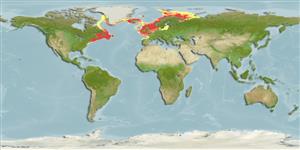Classificação / Names
Common names from other countries
Referência principal
Tamanho / Peso / Idade
Max length : 200 cm TL macho/indeterminado; (Ref. 1371); common length : 100.0 cm TL macho/indeterminado; (Ref. 1371); Peso máx. publicado: 96.0 kg (Ref. 9988); Idade máx. registada: 25 anos (Ref. 173)
Length at first maturity
Lm 63.4, range 31 - 74 cm
Ambiente
; marinhas; estuarina bentopelágico; oceanódromos (Ref. 51243); intervalo de profundidade 0 - 600 m (Ref. 1371), usually 150 - 200 m (Ref. 54441)
Clima / Intervalo
Temperate; ? - 15°C, preferred 6°C (Ref. 107945); 83°N - 35°N, 95°W - 86°E (Ref. 1371)
Distribuição
North Atlantic and Arctic: Ungava Bay in Canada along the North American coast to Cape Hatteras; North Carolina in the western Atlantic. East and west coast of Greenland; around Iceland; from Barents Sea including the region around Bear Island along the European coast to Bay of Biscay (Ref. 88171).
Países | Áreas FAO | Ecossistemas | Ocorrências | Introduções
Descrição suscinta
Espinhos dorsais (total): 0; Raios dorsais (total): 44-55; Espinhos anais 0; Raios anais : 33 - 45; Vértebras: 51 - 55. Protruding upper jaw, a conspicuous barbel on the lower jaw, and light lateral line, curved above the pectoral fins. Predorsal distance is less than one third of total length; body depth about 1/5 of total length. Color varies from brownish to greenish or gray dorsally and on upper sides, becoming pale and silvery ventrally. Peritoneum silvery.
Status na Lista Vermelha da IUCN (Ref. 115185)
Perigo para os humanos
Harmless
Uso pelos humanos
Pescarias: altamente comercial; Aquacultura: espécies comerciais; peixe esportivo: sim
Ferramentas
Relatórios especiais
Baixar XML
Fontes da internet
Estimates of some properties based on models
Phylogenetic diversity index
PD50 = 0.6250 many relatives (e.g. carps) 0.5 - 2.0 few relatives (e.g. lungfishes)
Nível Trófico
4.1 ±0.2 se; Based on diet studies.
Resiliência
Médio, tempo mínimo de duplicação da população 1,4 - 4,4 anos (rm=0.2-1.1; also (Ref. 36717))
Vulnerabilidade
High to very high vulnerability (65 of 100)
Categoria de preço
